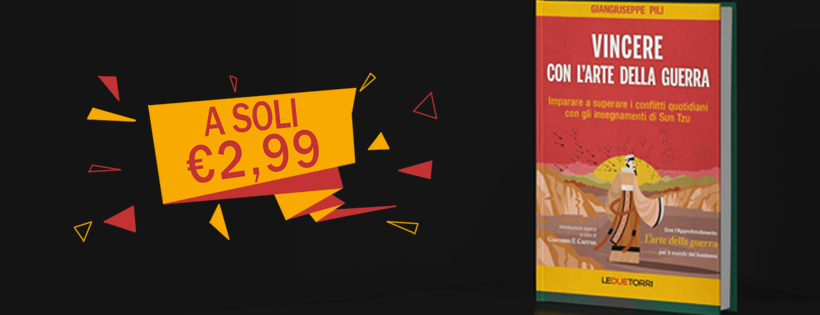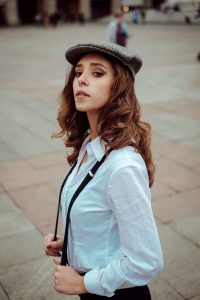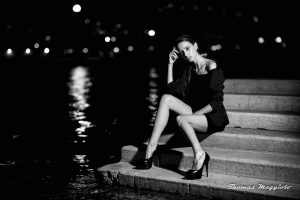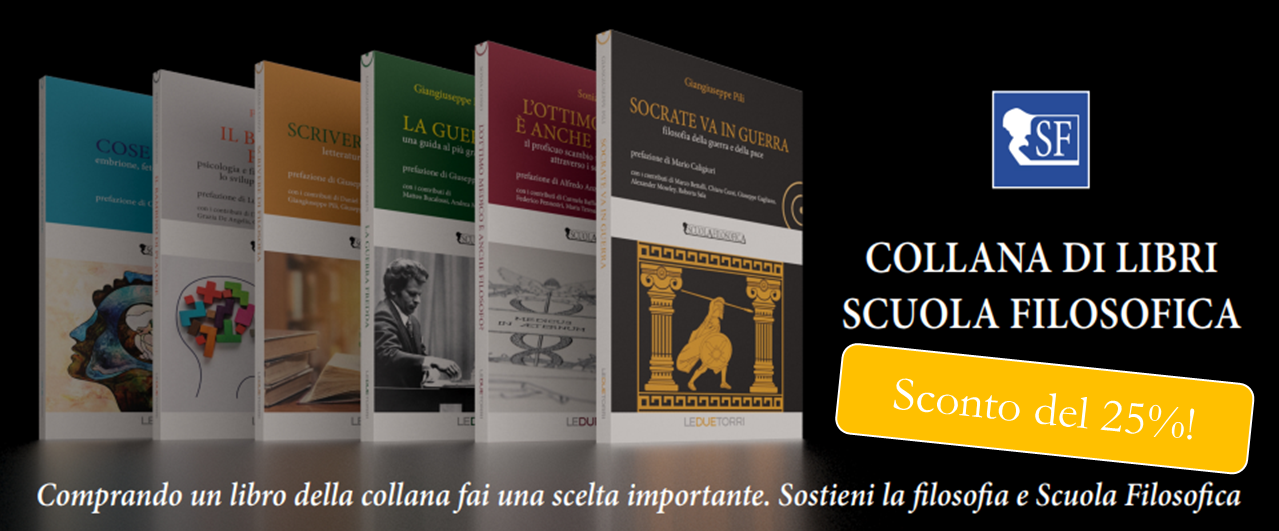Per Brodskij, forse non è necessario che il nobile cavaliere infili il piede nelle staffe della storia, se basta la generica impronta d’un quadrupede, lasciata per gli abitanti d’una città. Alla fine, per stratificare un intero popolo servirà la mitologia. Ma quanto il quadrupede d’una società si svilupperà dal quadrato d’una casa? Ludovica ha posato al mezzobusto, e di ¾. Lei indossa la coppola, mentre con le mani regge le bretelle dei pantaloni. Lo sguardo si percepisce abbastanza “intrigante”. Sullo sfondo, c’è una pavimentazione urbana a larghi quadrilateri. La camicia ha una tonalità quasi “vaporosa”. Le dita potrebbero incidere una storia privata, se costruite sulla forma tipografica. Magari a qualcuno lo sguardo di Ludovica parrà altero, ma più “fantasticamente” in quanto a “cullarsi” nei propri sentimenti, ed attraverso il glamour “vaporoso” della camicia.
According to Brodskij, maybe it is not necessary that the noble knight puts the foot through the stirrups of the history, if it is enough the general track of a quadruped, left for the inhabitants of a city. Finally, a mythology will be needed, to stratify an entire population. But how much will the quadruped of a society be developed from the square of a house? Ludovica posed through the head and shoulders, and in ¾. She wears the flat cap, while with the hands she bears the suspenders of the trousers. The gaze is perceived quite “intriguing”. On the background, there is an urban flooring in wide quadrilaterals. The shirt has a tone almost “vaporous”. The fingers could incise a private story, if they were built on a typographic shape. Maybe the gaze of Ludovica would seem haughty to somebody, however more “fantastically” because if it was in a “cradle” of the own feelings, and through a “vaporous” glamour of the shirt.
(Courtesy of Livio Tilotta)
Per Breton, liricamente la donna amata ha le braccia nel contempo di schiuma e di chiusa. La bellezza sa armonizzare la formosità sulla snellezza. Così, perfino l’acqua salata aiuterebbe la vita, mentre il mulino, con le sue pale, farà ondeggiare il “miscuglio falsamente impuro” del grano macinato. Angie è stata inquadrata per uno scatto in bianconero. Lei posa sedendosi sui gradini d’un accesso all’acqua: chissà se dolce o salata. Ci piace immaginare la configurazione “a mulino” degli arti, aventi una propulsione a pale. La scalinata potrebbe girare (complice la prospettiva dell’inquadratura fotografica). Qualcosa che avvierà virtualmente una “macinazione” delle onde. Forse, alla fine, s’alzerà una “piantina” a fuoco d’artificio, e perfettamente dalla proiezione del braccio destro, la cui mano, avendo le dita per “l’ormeggio” del volto, indurrebbe il pensiero a cogliere un giusto “pizzico di magia”, per la bellezza della vita. Qui si percepisce assai di più la schiuma, rispetto alla chiusa.
According to Breton, lyrically the loved woman has the arms in the same time of foam and sluice gate. The beauty is able to harmonize the buxomness on the slenderness. So, even the salt water would help the life, while the mill, with its blades, will allow a “jumble falsely impure”, of the ground wheat, to fluctuate. Angie was framed for a shot in black and white. She poses sitting on the steps of an entry to the water: who knows if fresh or salt. We like imagining the configuration “in a mill” of the limbs, which have a propulsion by the blades. The staircase could turn (with the complicity of the framing in photography). Something which will virtually start a “grinding” of the waves. Perhaps, finally, a “little plant” as firework will rise, and perfectly from the projection of the left arm, whose hand, having the fingers for “a mooring” of the face, would induce the thought to seize a right “pinch of magic”, for the beauty of the life. Here we perceive much more a foam, compared to a sluice gate.
(Courtesy of Thomas Maggiolo)
Per Antonio Colinas, noi possiamo sia rimanere a galla a destra ed a manca sulle onde che corrono come un remo perduto, sia seguire come i delfini la direzione “condannata” dal tempo. L’uomo non uscirà mai dalla sua finitudine: né sapendosi adattare, né rassicurato dall’automatismo. Annette sarebbe stata inquadrata sul lungolago. Il top allacciato al collo ha un design ad onde, le quali aumentano la sensualità, già data dalla trasparenza. La torsione del corpo (in posa più di profilo che a ¾) sobbalzerebbe fra l’acqua e la terra. Un lago è sempre ameno da percepire, senza richiedere una cura eccessiva per i frangiflutti. Il braccio sinistro punta verso di noi, e come un remo. Anche nella sicurezza d’una costa, servirà il supporto di qualcuno. C’è il dettaglio della giacca in pelle: questa medierebbe fra la legnosità (temporale) e la liquidità (situazionale).
According to Antonio Colinas, we can both stay afloat left and right on the waves that flow as a lost oar, and follow as the dolphins a direction “condemned” by the time. The man will never exit from his finitude: neither knowing how to adapt himself, nor reassured from an automatism. Annette would have been framed on the lakefront. The top tied at the neck has a design with the waves, which increase the sensuality, already given by the transparency. The torsion of the body (in a pose more in profile than in ¾) would jerk between the water and the land. A lake is always pleasant in its perception, without requesting an excessive care for the breakwater. The left arm aims to us, and like an oar. Also in the security of a coast, the support of somebody will be needed. There is the detail of a leather jacket: this one would mediate between the woodiness (temporal) and the liquidness (situational).
(Courtesy of Claudio Li Calzi)
Bibliografia – Bibliography
COLINAS A., Obra poetica completa: 1967-2010, Ediciones Siruela, Madrid 2011
PAVAN S., Lezioni di poesia: Iosif Brodskij e la cultura classica, Firenze University Press, Firenze 2006, p. 204
STOUT J.C., Objects observed, University of Toronto Press, Toronto 2018, p. 237
Biografia – Biography
La modella italiana Ludovica Provenzano viene da Finale Emilia (MO), e studia biologia.
The Italian model Ludovica Provenzano comes from Finale Emilia (Province of Modena), and she studies biology.
https://www.instagram.com/ludovicaprovenzano/
Il fotografo italiano Livio Tilotta vive ad Imola (BO), e ha studiato ingegneria elettronica.
The Italian photographer Livio Tilotta lives in Imola (Province of Bologna), and he studied electronic engineering.
La modella italiana Angie Colautti viene da Trieste, e ha studiato relazioni pubbliche.
The Italian model Angie Colautti comes from Trieste, and she studied public relations.
www.angiecolautti.com
Il fotografo Thomas Maggiolo viene da Vigonza (PD).
The Italian photographer Thomas Maggiolo comes from Vigonza (Province of Padua).
www.thomasmaggiolo.it
La modella Annette Stah è moldava, ma vive a Novara.
The model Annette Stah is Moldovan, but she lives in Novara (Italy).
Il fotografo Claudio Li Calzi lavora a Novara.
The Italian photographer Claudio Li Calzi works in Novara.







Be First to Comment